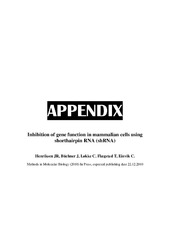| dc.contributor.advisor | Flægstad, Trond | |
| dc.contributor.author | Henriksen, Jørn Remi | |
| dc.date.accessioned | 2011-02-25T14:26:41Z | |
| dc.date.available | 2011-02-25T14:26:41Z | |
| dc.date.issued | 2010-12-03 | |
| dc.description.abstract | Neuroblastoma is the most common extra-cranial tumour disease in children, and accounts for 15% of all childhood cancer deaths. MYCN is a transcription factor and a proto-oncogene that most often initiates transcription of target genes involved in increased proliferation and inhibition of differentiation. MYCN amplified neuroblastoma represents the most aggressive form of this disease. Silencing of MYCN is an attractive approach for understanding the role of this gene in development and disease.
MYCN is involved in development, proliferation and differentiation. In order to explore its functions in detail, it is a great advantage to be able to silence its expressions in all cells present for an indefinite period of time, and at any suitable time-point. In paper I we describe a novel design of an inducible H1 promoter capable of delivering shRNA in a conditional manner. This versatile system allows inducible expression of any desired shRNA. In paper II this promoter is used to control the conditional expression of anti-MYCN shRNAs from cassettes stably integrated in two MYCN-amplified cell lines. Here MYCN is silenced when the inducer doxycycline is added to the media, resulting in increased differentiation and reduced proliferation of the MYCN amplified cell lines.
MiRNAs are small non-coding RNA shown to regulate the expression of a vast amount of proteins in humans. In paper III we investigate the effect of MYCN suppression on the global miRNA expression in MYCN-amplified neuroblastoma. We find that reduced MYCN expression leads to both increased and reduced expression of several miRNAs. The function of mir-21 is investigated further, and no effect on neither proliferation nor differentiation is found. Other miRNAs demonstrated to be regulated by MYCN, is mir-92a and mir-92b. In paper IV we demonstrate how these miRNAs suppresses the expression of DKK3, a tumour suppressor gene often found to be down-regulated in MYCN-amplified neuroblastoma. | en |
| dc.description.doctoraltype | ph.d. | en |
| dc.identifier.uri | https://hdl.handle.net/10037/2966 | |
| dc.identifier.urn | URN:NBN:no-uit_munin_2697 | |
| dc.language.iso | eng | en |
| dc.publisher | Universitetet i Tromsø | en |
| dc.publisher | University of Tromsø | en |
| dc.rights.accessRights | openAccess | |
| dc.rights.holder | Copyright 2010 The Author(s) | |
| dc.rights.uri | https://creativecommons.org/licenses/by-nc-sa/3.0 | en_US |
| dc.rights | Attribution-NonCommercial-ShareAlike 3.0 Unported (CC BY-NC-SA 3.0) | en_US |
| dc.subject | VDP::Teknologi: 500::Bioteknologi: 590 | en |
| dc.subject | Neuroblastoma | en |
| dc.subject | MYCN | en |
| dc.subject | microRNA | en |
| dc.subject | miRNA | en |
| dc.subject | RNAi | en |
| dc.subject | shRNA | en |
| dc.subject | mir-21 | en |
| dc.subject | DKK3 | en |
| dc.title | Targeted MYCN suppression and its effect on miRNA in neuroblastoma | en |
| dc.type | Doctoral thesis | en |
| dc.type | Doktorgradsavhandling | en |


 English
English norsk
norsk






